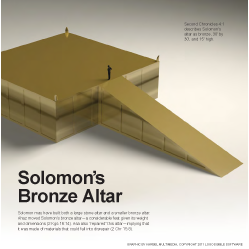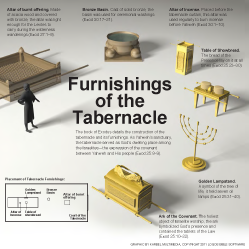4:1–5:1 Second Chronicles does not include a description of Solomon’s palace (compare 1 Kgs 7:1–12). Instead, it shifts directly to describing the temple’s furnishings. As with the report of the temple itself (2 Chron 3:1–17), 2 Chronicles provides fewer details than 1 Kings (compare 1 Kgs 7:13–51). |
4:1 he made an altar of bronze Compare Ezek 43:13–27 and note.
4:2 from brim to brim it was ten cubits About 15 feet in diameter (a cubit is roughly 1.5 feet).
4:3 cast as one piece with it Indicates that the sea and its decorations were made from a single piece of bronze.
4:4 standing upon twelve oxen See 1 Kgs 7:25 and note.
4:5 a handbreadth Refers to the width of a person’s four fingers held together, approximately three inches.
it held three thousand baths Approximately 17,500 gallons. The volume given here differs from that in 1 Kgs 7:26 (2,000 baths).
4:6 And he made ten basins According to the account in 1 Kings, each of these held 40 baths, or approximately 230 gallons (1 Kgs 7:38–39).
4:7 ten golden lampstands In connection with the tabernacle, Yahweh gave Moses instructions for a single lampstand (see Exod 25:31 and note).
4:8 And he made ten tables Most likely for the showbread (2 Chron 4:19; 1 Chr 28:16).
4:10 And he set the sea See 2 Chron 4:2–5.
4:11 the pots, the shovels, and the drinking bowls Utensils used for sacrifices. See 1 Kgs 7:40 and note; Exod 27:3.
4:12 the two columns Described in 2 Chron 3:15–17.
4:16 Huram-abi The craftsman from Tyre (introduced in 2:13–14).
polished bronze See 1 Kgs 7:45 and note.
4:17 Succoth and Zeredah Cities along the eastern bank of the Jordan River.
River.
4:19 the altar of gold Modeled after the altar of incense in the tabernacle (Exod 30:1–10).
in the tabernacle (Exod 30:1–10).
the bread of the presence See Lev 24:5–9; note on Lev 24:6.
4:22 dishes Probably refers to a spoon-shaped utensil used for incense (Exod 25:29).
the entrance to the house The Hebrew phrase used here, phethach habbayith, may be literally rendered as “the opening of the house.” The account in 1 Kings uses the word pothoth, which can indicate door hinges (1 Kgs 7:50).

|
About Faithlife Study BibleFaithlife Study Bible (FSB) is your guide to the ancient world of the Old and New Testaments, with study notes and articles that draw from a wide range of academic research. FSB helps you learn how to think about interpretation methods and issues so that you can gain a deeper understanding of the text. |
| Copyright |
Copyright 2012 Logos Bible Software. |
| Support Info | fsb |
 Loading…
Loading…



